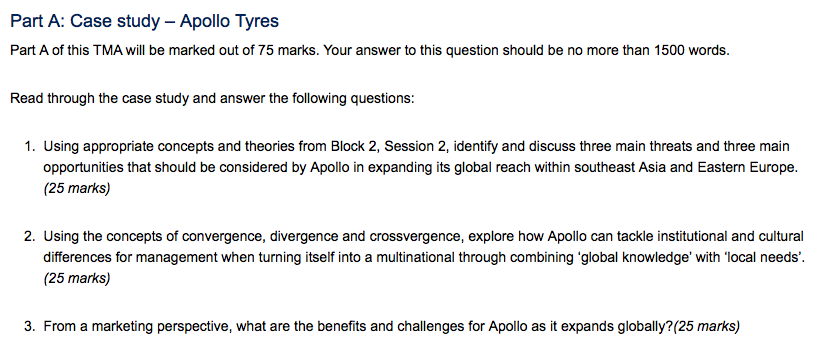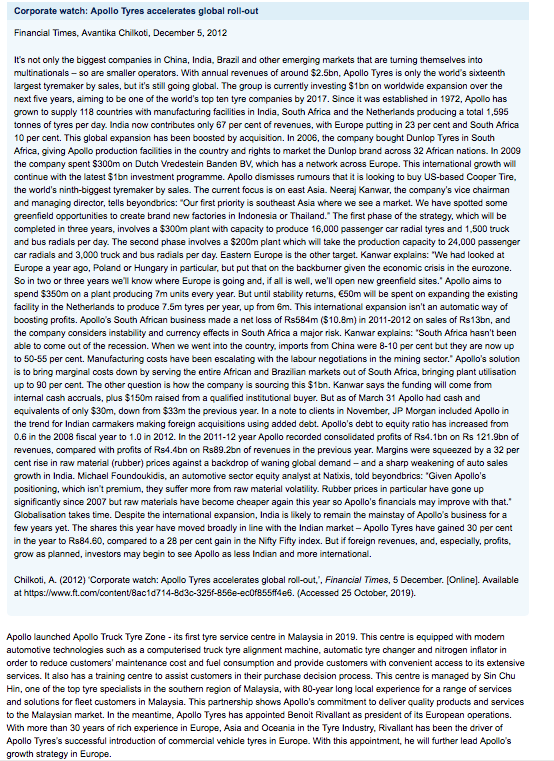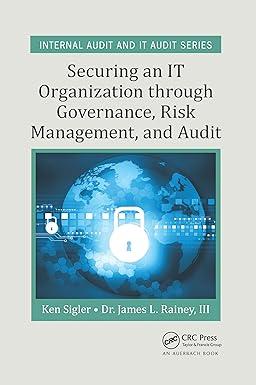


Part A: Case study - Apollo Tyres Part A of this TMA will be marked out of 75 marks. Your answer to this question should be no more than 1500 words. Read through the case study and answer the following questions: 1. Using appropriate concepts and theories from Block 2, Session 2, identify and discuss three main threats and three main opportunities that should be considered by Apollo in expanding its global reach within southeast Asia and Eastern Europe. (25 marks) 2. Using the concepts of convergence, divergence and crossvergence, explore how Apollo can tackle institutional and cultural differences for management when turning itself into a multinational through combining global knowledge' with local needs'. (25 marks) 3. From a marketing perspective, what are the benefits and challenges for Apollo as it expands globally?(25 marks) Corporate watch: Apollo Tyres accelerates global roll-out Financial Times, Avantika Chilkoti, December 5, 2012 It's not only the biggest companies in China, India, Brazil and other emerging markets that are turning themselves into multinationals - so are smaller operators. With annual revenues of around $2.5bn, Apollo Tyres is only the world's sixteenth largest tyremaker by sales, but it's still going global. The group is currently investing $1bn on worldwide expansion over the next five years, aiming to be one of the world's top ten tyre companies by 2017. Since it was established in 1972, Apollo has grown to supply 118 countries with manufacturing facilities in India, South Africa and the Netherlands producing a total 1,595 tonnes of tyres per day. India now contributes only 67 per cent of revenues, with Europe putting in 23 per cent and South Africa 10 per cent. This global expansion has been boosted by acquisition. In 2006, the company bought Dunlop Tyres in South Africa, giving Apollo production facilities in the country and rights to market the Dunlop brand across 32 African nations. In 2009 the company spent $300m on Dutch Vredestein Banden BV, which has a network across Europe. This international growth will continue with the latest $1bn investment programme. Apollo dismisses rumours that it is looking to buy US-based Cooper Tire, the world's ninth-biggest tyremaker by sales. The current focus is on east Asia. Neeraj Kanwar, the company's vice chairman and managing director, tells beyondbrics: "Our first priority is southeast Asia where we see a market. We have spotted some greenfield opportunities to create brand new factories in Indonesia or Thailand." The first phase of the strategy, which will be completed in three years, involves a $300m plant with capacity to produce 16,000 passenger car radial tyres and 1,500 truck and bus radials per day. The second phase involves a $200m plant which will take the production capacity to 24,000 passenger car radials and 3.000 truck and bus radials per day. Eastern Europe is the other target. Kanwar explains: "We had looked at Europe a year ago, Poland or Hungary in particular, but put that on the backburner given the economic crisis in the eurozone. So in two or three years we'll know where Europe is going and, if all is well, we'll open new greenfield sites." Apollo aims to spend $350m on a plant producing 7m units every year. But until stability returns, 50m will be spent on expanding the existing facility in the Netherlands to produce 7.5m tyres per year, up from 6m. This international expansion isn't an automatic way of boosting profits. Apollo's South African business made a net loss of Rs584m ($10.8m) in 2011-2012 on sales of Rs13bn, and the company considers instability and currency effects in South Africa a major risk. Kanwar explains: "South Africa hasn't been able to come out of the recession. When we went into the country, imports from China were 8-10 per cent but they are now up to 50-55 per cent. Manufacturing costs have been escalating with the labour negotiations in the mining sector.' Apollo's solution is to bring marginal costs down by serving the entire African and Brazilian markets out of South Africa, bringing plant utilisation up to 90 per cent. The other question is how the company is sourcing this $1bn. Kanwar says the funding will come from internal cash accruals, plus $150m raised from a qualified institutional buyer. But as of March 31 Apollo had cash and equivalents of only $30m, down from $33m the previous year. In a note to clients in November, JP Morgan included Apollo in the trend for Indian carmakers making foreign acquisitions using added debt. Apollo's debt to equity ratio has increased from 0.6 in the 2008 fiscal year to 1.0 in 2012. In the 2011-12 year Apollo recorded consolidated profits of Rs4.1bn on Rs 121.9bn of revenues, compared with profits of Rs4.4bn on Rs89.2bn of revenues in the previous year. Margins were squeezed by a 32 per cent rise in raw material (rubber) prices against a backdrop of waning global demand and a sharp weakening of auto sales growth in India. Michael Foundoukidis, an automotive sector equity analyst at Natixis, told beyondbrics: "Given Apollo's positioning, which isn't premium, they suffer more from raw material volatility. Rubber prices in particular have gone up significantly since 2007 but raw materials have become cheaper again this year so Apollo's financials may improve with that." Globalisation takes time. Despite the international expansion, India is likely to remain the mainstay of Apollo's business for a few years yet. The shares this year have moved broadly in line with the Indian market - Apollo Tyres have gained 30 per cent in the year to Rs84.60, compared to a 28 per cent gain in the Nifty Fifty index. But if foreign revenues, and, especially, profits, grow as planned, investors may begin to see Apollo as less Indian and more international. Chilkoti, A. (2012) "Corporate watch: Apollo Tyres accelerates global roll-out,', Financial Times, 5 December. [Online]. Available at https://www.ft.com/content/8ac1d714-8d30-325f-456e-ec0f855ff4e6. (Accessed 25 October, 2019). Apollo launched Apollo Truck Tyre Zone - its first tyre service centre in Malaysia in 2019. This centre is equipped with modem automotive technologies such as a computerised truck tyre alignment machine, automatic tyre changer and nitrogen infilator in order to reduce customers' maintenance cost and fuel consumption and provide customers with convenient access to its extensive services. It also has a training centre to assist customers in their purchase decision process. This centre is managed by Sin Chu Hin, one of the top tyre specialists in the southern region of Malaysia, with 80-year long local experience for a range of services and solutions for fleet customers in Malaysia. This partnership shows Apollo's commitment to deliver quality products and services to the Malaysian market. In the meantime, Apollo Tyres has appointed Benoit Rivallant as president of its European operations. With more than 30 years of rich experience in Europe, Asia and Oceania in the Tyre Industry, Rivallant has been the driver of Apollo Tyres's successful introduction of commercial vehicle tyres in Europe. With this appointment, he will further lead Apollo's growth strategy in Europe. Part B: Block 2 mind map Part B of this TMA will be marked out of 15 marks. Create a mind map showing how the main themes and concepts from Block 2, Competing in a global context', relate to each other. Your mind map should be no more than 250 words. Part C: Demonstrating your skills and knowledge development Part of this TMA will be marked out of 10 marks. Attach one of your answers to one of the activities in Block 2 and write a short commentary in no more than 250 words explaining how it would demonstrate to an employer your improved skills and/or knowledge of business and management. Note that your answer to the Block 2 activity does not count towards the word count for Part C, but your commentary on it does. Part A: Case study - Apollo Tyres Part A of this TMA will be marked out of 75 marks. Your answer to this question should be no more than 1500 words. Read through the case study and answer the following questions: 1. Using appropriate concepts and theories from Block 2, Session 2, identify and discuss three main threats and three main opportunities that should be considered by Apollo in expanding its global reach within southeast Asia and Eastern Europe. (25 marks) 2. Using the concepts of convergence, divergence and crossvergence, explore how Apollo can tackle institutional and cultural differences for management when turning itself into a multinational through combining global knowledge' with local needs'. (25 marks) 3. From a marketing perspective, what are the benefits and challenges for Apollo as it expands globally?(25 marks) Corporate watch: Apollo Tyres accelerates global roll-out Financial Times, Avantika Chilkoti, December 5, 2012 It's not only the biggest companies in China, India, Brazil and other emerging markets that are turning themselves into multinationals - so are smaller operators. With annual revenues of around $2.5bn, Apollo Tyres is only the world's sixteenth largest tyremaker by sales, but it's still going global. The group is currently investing $1bn on worldwide expansion over the next five years, aiming to be one of the world's top ten tyre companies by 2017. Since it was established in 1972, Apollo has grown to supply 118 countries with manufacturing facilities in India, South Africa and the Netherlands producing a total 1,595 tonnes of tyres per day. India now contributes only 67 per cent of revenues, with Europe putting in 23 per cent and South Africa 10 per cent. This global expansion has been boosted by acquisition. In 2006, the company bought Dunlop Tyres in South Africa, giving Apollo production facilities in the country and rights to market the Dunlop brand across 32 African nations. In 2009 the company spent $300m on Dutch Vredestein Banden BV, which has a network across Europe. This international growth will continue with the latest $1bn investment programme. Apollo dismisses rumours that it is looking to buy US-based Cooper Tire, the world's ninth-biggest tyremaker by sales. The current focus is on east Asia. Neeraj Kanwar, the company's vice chairman and managing director, tells beyondbrics: "Our first priority is southeast Asia where we see a market. We have spotted some greenfield opportunities to create brand new factories in Indonesia or Thailand." The first phase of the strategy, which will be completed in three years, involves a $300m plant with capacity to produce 16,000 passenger car radial tyres and 1,500 truck and bus radials per day. The second phase involves a $200m plant which will take the production capacity to 24,000 passenger car radials and 3.000 truck and bus radials per day. Eastern Europe is the other target. Kanwar explains: "We had looked at Europe a year ago, Poland or Hungary in particular, but put that on the backburner given the economic crisis in the eurozone. So in two or three years we'll know where Europe is going and, if all is well, we'll open new greenfield sites." Apollo aims to spend $350m on a plant producing 7m units every year. But until stability returns, 50m will be spent on expanding the existing facility in the Netherlands to produce 7.5m tyres per year, up from 6m. This international expansion isn't an automatic way of boosting profits. Apollo's South African business made a net loss of Rs584m ($10.8m) in 2011-2012 on sales of Rs13bn, and the company considers instability and currency effects in South Africa a major risk. Kanwar explains: "South Africa hasn't been able to come out of the recession. When we went into the country, imports from China were 8-10 per cent but they are now up to 50-55 per cent. Manufacturing costs have been escalating with the labour negotiations in the mining sector.' Apollo's solution is to bring marginal costs down by serving the entire African and Brazilian markets out of South Africa, bringing plant utilisation up to 90 per cent. The other question is how the company is sourcing this $1bn. Kanwar says the funding will come from internal cash accruals, plus $150m raised from a qualified institutional buyer. But as of March 31 Apollo had cash and equivalents of only $30m, down from $33m the previous year. In a note to clients in November, JP Morgan included Apollo in the trend for Indian carmakers making foreign acquisitions using added debt. Apollo's debt to equity ratio has increased from 0.6 in the 2008 fiscal year to 1.0 in 2012. In the 2011-12 year Apollo recorded consolidated profits of Rs4.1bn on Rs 121.9bn of revenues, compared with profits of Rs4.4bn on Rs89.2bn of revenues in the previous year. Margins were squeezed by a 32 per cent rise in raw material (rubber) prices against a backdrop of waning global demand and a sharp weakening of auto sales growth in India. Michael Foundoukidis, an automotive sector equity analyst at Natixis, told beyondbrics: "Given Apollo's positioning, which isn't premium, they suffer more from raw material volatility. Rubber prices in particular have gone up significantly since 2007 but raw materials have become cheaper again this year so Apollo's financials may improve with that." Globalisation takes time. Despite the international expansion, India is likely to remain the mainstay of Apollo's business for a few years yet. The shares this year have moved broadly in line with the Indian market - Apollo Tyres have gained 30 per cent in the year to Rs84.60, compared to a 28 per cent gain in the Nifty Fifty index. But if foreign revenues, and, especially, profits, grow as planned, investors may begin to see Apollo as less Indian and more international. Chilkoti, A. (2012) "Corporate watch: Apollo Tyres accelerates global roll-out,', Financial Times, 5 December. [Online]. Available at https://www.ft.com/content/8ac1d714-8d30-325f-456e-ec0f855ff4e6. (Accessed 25 October, 2019). Apollo launched Apollo Truck Tyre Zone - its first tyre service centre in Malaysia in 2019. This centre is equipped with modem automotive technologies such as a computerised truck tyre alignment machine, automatic tyre changer and nitrogen infilator in order to reduce customers' maintenance cost and fuel consumption and provide customers with convenient access to its extensive services. It also has a training centre to assist customers in their purchase decision process. This centre is managed by Sin Chu Hin, one of the top tyre specialists in the southern region of Malaysia, with 80-year long local experience for a range of services and solutions for fleet customers in Malaysia. This partnership shows Apollo's commitment to deliver quality products and services to the Malaysian market. In the meantime, Apollo Tyres has appointed Benoit Rivallant as president of its European operations. With more than 30 years of rich experience in Europe, Asia and Oceania in the Tyre Industry, Rivallant has been the driver of Apollo Tyres's successful introduction of commercial vehicle tyres in Europe. With this appointment, he will further lead Apollo's growth strategy in Europe. Part B: Block 2 mind map Part B of this TMA will be marked out of 15 marks. Create a mind map showing how the main themes and concepts from Block 2, Competing in a global context', relate to each other. Your mind map should be no more than 250 words. Part C: Demonstrating your skills and knowledge development Part of this TMA will be marked out of 10 marks. Attach one of your answers to one of the activities in Block 2 and write a short commentary in no more than 250 words explaining how it would demonstrate to an employer your improved skills and/or knowledge of business and management. Note that your answer to the Block 2 activity does not count towards the word count for Part C, but your commentary on it does









